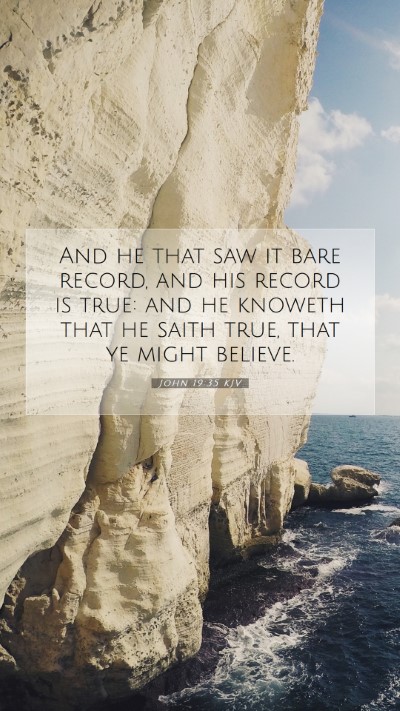Understanding John 19:35 - Explanation and Commentary
Bible Verse: John 19:35 - "And he that saw it bare record, and his record is true: and he knoweth that he saith true, that ye might believe."
Introduction
The verse John 19:35 holds a significant position in the New Testament, as it relates to the events surrounding the crucifixion of Jesus Christ. It provides assurance about the truth of the gospel and the importance of believing in the resurrection. This analysis will explore the meaning of this verse, drawing insights from public domain commentaries to enhance our bible verse understanding.
Verse Interpretation and Meaning
In John 19:35, the Apostle John emphasizes the reliability of his testimony about the events surrounding the crucifixion. The statement "and he that saw it bare record" indicates that John is an eyewitness to the events he describes. His intention is clear: by affirming the truth of his account, he invites the readers to believe in Jesus Christ.
Emphasis on Truth
Matthew Henry notes that John seeks to establish credibility by declaring that his record is true. The phrase "his record is true" signifies that John's testimony is not just an opinion but a factual account based on evidence. In the context of Bible verse meanings, this passage emphasizes the reliability of the New Testament witness.
The Importance of Faith
John's purpose in writing this verse is to bolster the faith of believers. According to Albert Barnes, the phrase "that ye might believe" highlights the evangelistic aspect of the Gospel. This verse serves as a reminder that the facts surrounding the crucifixion and resurrection of Christ are intended to elicit a response of faith from the reader.
Eyewitness Testimony
Adam Clarke points out that John's designation as an eyewitness is crucial in establishing the authenticity of the Gospel. The witness of an eyewitness holds great weight in legal contexts and ensures that the claims made about Jesus’ life and resurrection are credible. This opens a door for deeper Bible study insights into how written testimony affects the faith journey of believers.
Historical Context
This verse occurs at a pivotal moment in the narrative of Jesus' crucifixion. Understanding the historical context is vital for interpreting the meaning accurately. The Gospel of John was written to a community of believers facing persecution and skepticism. Thus, John's purpose in reiterating the truth of Jesus’ death and the assurance it brings to believers cannot be overstated.
Application to Daily Life
The message found in John 19:35 extends beyond its historical and narrative context. It is relevant to modern-day believers seeking understanding in troubling times. As stated in various Bible study resources, believers are encouraged to find strength in the eyewitness accounts of Jesus’ love and sacrifice. This leads to a deeper reflection on how faith is rooted in trust in the truth of God's Word.
Additional Insights
- Assurance in God's Promises: John’s account serves as a reminder of God’s faithfulness and the hope that believers have in eternal life.
- Call to Witness: Like John, believers are called to be witnesses of truth in their own lives, sharing their testimonies with others.
- The Role of Scripture: This passage encourages the examination of Scripture as a means to strengthen one’s faith and understanding of God’s narrative throughout history.
Cross References
- Matthew 28:17-20 - The Great Commission
- 1 John 5:9-13 - The testimony of God about His Son
- Acts 1:8 - The call to be witnesses
Conclusion
In summary, John 19:35 reinforces the significance of eyewitness testimony in the Christian faith and calls believers to deepen their understanding of the truth of the resurrection. It serves not only as a historical record but also as a profound reminder of the purpose behind the Gospel—a call to belief and a life transformed by faith in Christ. For further exploration, engaging in online Bible study or joining bible study groups can provide more insights into the significance of such verses.


